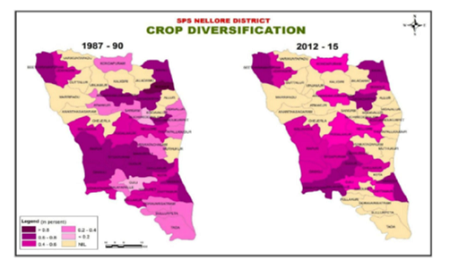
Geo-Eye
Department of Geography & GIS

Department of Geography & GIS

Geo-Eye
Year: 2019, Volume: 8, Issue: 2, Pages: 54-56
Original Article
N Bala Ankanna1, A Krishna Kumari1
1Department of Geography, Sri Krishnadevaraya University, Anantapuramu, Andhra Pradesh, India
Received Date:10 August 2019, Accepted Date:22 December 2019
The magnitude of agricultural diversification shows the impact of physical, socio-economic and techno-organizational influents, especially physical environs. It is increasingly recognized that a study of the spatial patterns of agricultural diversification is of vital importance and almost indispensable in understanding the competition that goes on among different agricultural activities for space. In general, it appears that keen competition for agricultural land and adoption of judicious crop rotation for the maintenance of soil fertility are associated with a mixed farming system rather than crop specialization. But, the choice of a cropping system is dependent primarily on physical variables and secondarily on technical and economic considerations. In certain pockets of irrigated lands, contrastingly crop specialization is more prominent rather than crop diversification. To observe this, an endeavour is made here to study the geographical patterns of crop diversification in Nellore district of Andhra Pradesh, where irrigation plays major role in the cultivation of crops. Gibbs-Martin Index of diversification is applied here for the crop data of two trienniums i.e.,1987-90 and 2012-15.
© 2019 Ankanna & Kumari. This is an open-access article distributed under the terms of the Creative Commons Attribution License, which permits unrestricted use, distribution, and reproduction in any medium, provided the original author and source are credited.
Published By Bangalore University, Bengaluru, Karnataka
Subscribe now for latest articles and news.